A good crowd has shown up for the 12th session of the Living Wage Lab. One thing that the Living Wage Lab offers to participants, is the certainty to find a trusted space for discussion and for experimentation. The idea of experimenting is well alive in the Freedom Lab in Amsterdam, the space where this Lab session takes place. It serves as a reminder of the principles on which we operate. Exploring and experimenting are key components of the Lab.
This is something Eelco Fortuijn from Electronics Watch is well aware of. He has experimented by starting many initiatives, he says. Some have failed and some have succeeded. Don’t be afraid to fail, he tells the Lab participants, as that’s part of trial and error and will lead to successes.
Contract clauses – an example from the electronics sector
Electronics Watch delivers due diligence as a service. They help public sector buyers, currently 85 affiliates, from within the European Union to buy IT products from risk countries responsibly. Electronics Watch aims to uphold a standard of labour practices that reflects international legal standards, and as such it also refers to the right of a living wage.
These standards are stipulated in the contracts between the public sector buyer and the supplier of a specific batch of IT products. An important tool Electronics Watch uses in this respect is a domino letter. Such a letter can be used by the supplier of the IT product batch to obtain specific producing or sourcing information in order to analyze and manage risks.
The supplier sends the letter upstream in the supply chain, until it reaches the producer of raw materials. Electronics Watch monitors this process closely and follows up with the suppliers accordingly. A clause in the contract on fair trading principles makes it possible for suppliers upstream to renegotiate better terms with buyers in order to improve working conditions or to obtain a fair price for their product.
Payment of a living wage cannot be enforced through the contract clause conditions. However, it can oblige suppliers to make a living wage plan if low wages are a risk in the supply chain. In this instance, buyers are required to commit to paying 80% of the extra costs for the living wage and suppliers 20%.
Is this a model that can be copied to the supply chains where the Living Wage Lab participants work? Eelco is optimistic when he offers some advice to the participants. ‘’Products made by people earning living wages is something that the government can make compulsory. When they do, you can be the first one to actually deliver such a product.‘’
Results living wage toolkit needs assessment & mock-up tools
True Price is in the stages of finalizing the research for the living wage toolkit needs assessment. They have conducted 21 interviews with different organizations in the agri-food supply chain. They have interviewed people in CSR positions, quality management, management positions, and in procurement. Common challenges that were identified amongst the respondents related to the lack of insight into the value chain, a lack of resources and a low priority of the topic of living wage.
Although there are quite a few living wage tools readily available, most tools are not used at the moment by the respondents. A toolkit of the Living Wage Lab could build on existing tools and resources while adding interactivity, personalization and bringing in a sector focus.
During the lab session, mock-ups of four possible tools (a customized information document, a living wage resource wizard, a customized living wage action list, and a light living wage calculation tool) were discussed in small groups, focusing on the value of the potential tools and required content.
Participants found all tools could be valuable in enabling a living wage dialogue throughout the supply chain while also starting a conversation internally. Still, a toolkit, in whatever shape, won’t be able to solve the problem of living wage, any success depends on the steps and interactions taken afterwards. Several participants mentioned that a toolkit could especially be useful if it would show a business case for a living wage and if it would lead to a more transparent supply chain.
Hivos, Fairfood and UTZ will, based on the needs assessment and feedback from lab sessions, determine which tools to develop (first). This will be done in close coordination with the Living Income Community and the Global Living Wage Coalition, which just launched a new website (www.globallivingwage.org). Check it out and sign up to stay on top of their latest benchmark studies and other news and events!
See you in October/November for our next Lab session – an invitation will follow in September.
Enjoy your summer!



